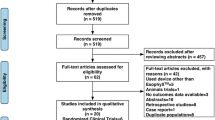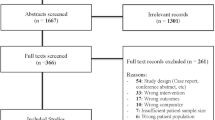Abstract
Background
The literature of endoluminal treatment of gastroesophageal reflux disease (GERD) widely varies in the level of evidence presented for analysis. Therefore there is a need for a comprehensive evidence-based medicine (EBM) analysis of the current literature evidence of the three FDA-approved modalities used for endoluminal treatment of GERD.
Search strategy
In January 2007, the MEDLINE database was searched for randomized controlled trials (RCTs), and controlled clinical trials of currently available endoluminal treatment of GERD. Database searches combined the specific endoluminal device keywords with the condition-specific keyword (e.g., GERD).
Data collection and analysis
All relevant studies have been categorized according to the evidence they provide according to the guidelines for Levels of Evidence and Grades of Recommendation supplied by the Oxford Centre for Evidence-Based Medicine.
Main results and Authors’ Conclusion
Sixteen studies met the inclusion criteria, representing 787 patients. The methodological quality of most of the included studies was average; four studies were grade 1b (individual randomized trial), 10 were grade 2b (individual cohort study), and two were grade 3b (individual case-control study)
There is grade 1b and 2b evidence demonstrating the EndoCinch plication is effective in reducing GERD symptoms at short-term follow up. However, in the majority of the studies analyzed, the procedure does not significantly reduce the acid exposure in the distal esophagus. The majority of the studies with long-term outcome showed disappointing outcomes, probably due to suture loss in the majority of patients.
There is grade 1b and 2b evidence demonstrating that the Stretta procedure is effective in reducing GERD symptoms at short- and mid-term follow up. However, in the majority of the studies analyzed, the procedure did not reduce significantly the acid exposure in the distal esophagus.
There is grade 1b and 2b evidence demonstrating that full-thickness plication is effective in reducing GERD symptoms, and acid exposure in the distal esophagus.





Similar content being viewed by others
References
Donahue PE, Carvalho P, Yoshida J, Miidla I, Shen YJ, Bombeck CT, Nyhus LM (1989) Endoscopic sclerosis of the cardia affects gastroesophageal reflux. Surg Endosc 3: 11–2
Pearl JP, Marks JM (2007) Endolumenal therapies for gastroesophageal reflux disease: are they dead? Surg Endosc 21: 1–4
Tintillier M, Chaput A, Kirch L, Martinet JP, Pochet JM, Cuvelier C (2004) Esophageal abscess complicating endoscopic treatment of refractory gastroesophageal reflux disease by Enteryx injection: a first case report. Am J Gastroenterol 99: 1856–1858
Wong RF, Davis TV, Peterson KA (2005) Complications involving the mediastinum after injection of Enteryx for GERD. Gastrointest Endosc 61: 753–756
Fockens P, Bruno MJ, Gabbrielli A, Odegaard S, Hatlebakk J, Allescher HD, Rosch T, Rhodes M, Bastid C, Rey J, Boyer J, Muehldorffer S, van den Hombergh U, Costamagna G (2004) Endoscopic augmentation of the lower esophageal sphincter for the treatment of gastroesophageal reflux disease: multicenter study of the Gatekeeper Reflux Repair System. Endoscopy 36: 682–689
Swain P, Park PO, Mills T (2003) Bard EndoCinch: the device, the technique, and pre-clinical studies. Gastrointest Endosc Clin N Am 13: 75–88
Lutfi RE, Torquati A, Richards WO (2004) The endoscopic radiofrequency approach to management of GERD. Curr Opin Otolaryngol Head Neck Surg 12: 191–196
Schwartz MP, Wellink H, Gooszen HG, Conchillo JM, Samsom M, Smout AJ (2007) Endoscopic gastroplication for the treatment of gastro-oesophageal reflux disease: a randomised, sham-controlled trial. Gut 56: 20–28
Montgomery M, Hakanson B, Ljungqvist O, Ahlman B, Thorell A (2006) Twelve months’ follow-up after treatment with the EndoCinch endoscopic technique for gastro-oesophageal reflux disease: a randomized, placebo-controlled study. Scand J Gastroenterol 41: 1382–1389
Schiefke I, Zabel-Langhennig A, Neumann S, Feisthammel J, Moessner J, Caca K (2005) Long term failure of endoscopic gastroplication (EndoCinch). Gut 54: 752–758
Mahmood Z, McMahon BP, Arfin Q, Byrne PJ, Reynolds JV, Murphy EM, Weir DG (2003) Endocinch therapy for gastro-oesophageal reflux disease: a one year prospective follow up. Gut 52: 34–39
Filipi CJ, Lehman GA, Rothstein RI, Raijman I, Stiegmann GV, Waring JP, Hunter JG, Gostout CJ, Edmundowicz SA, Dunne DP, Watson PA, Cornet DA (2001) Transoral, flexible endoscopic suturing for treatment of GERD: a multicenter trial. Gastrointest Endosc 53: 416–422
Rothstein RI, Filipi CJ (2003) Endoscopic suturing for gastroesophageal reflux disease: clinical outcome with the Bard EndoCinch. Gastrointest Endosc Clin N Am 13: 89–101
Tam WC, Schoeman MN, Zhang Q, Dent J, Rigda R, Utley D, Holloway RH (2003) Delivery of radiofrequency energy to the lower oesophageal sphincter and gastric cardia inhibits transient lower oesophageal sphincter relaxations and gastro-oesophageal reflux in patients with reflux disease. Gut 52: 479–485
DiBaise JK, Brand RE, Quigley EM (2002) Endoluminal delivery of radiofrequency energy to the gastroesophageal junction in uncomplicated GERD: efficacy and potential mechanism of action. Am J Gastroenterol 97: 833–842
Corley DA, Katz P, Wo JM, Stefan A, Patti M, Rothstein R, Edmundowicz S, Kline M, Mason R, Wolfe MM (2003) Improvement of gastroesophageal reflux symptoms after radiofrequency energy: a randomized, sham-controlled trial. Gastroenterology 125: 668–676
Triadafilopoulos G, DiBaise JK, Nostrant TT, Stollman NH, Anderson PK, Wolfe MM, Rothstein RI, Wo JM, Corley DA, Patti MG, Antignano LV, Goff JS, Edmundowicz SA, Castell DO, Rabine JC, Kim MS, Utley DS (2002) The Stretta procedure for the treatment of GERD: 6 and 12 month follow-up of the U.S. open label trial. Gastrointest Endosc 55: 149–156
Richards WO, Houston HL, Torquati A, Khaitan L, Holzman MD, Sharp KW (2003) Paradigm shift in the management of gastroesophageal reflux disease. Ann Surg 237: 638–647; discussion 648–9
Cipolletta L, Rotondano G, Dughera L, Repici A, Bianco MA, De Angelis C, Vingiani AM, Battaglia E (2005) Delivery of radiofrequency energy to the gastroesophageal junction (Stretta procedure) for the treatment of gastroesophageal reflux disease. Surg Endosc 19: 849–853
Torquati A, Houston HL, Kaiser J, Holzman MD, Richards WO (2004) Long-term follow-up study of the Stretta procedure for the treatment of gastroesophageal reflux disease. Surg Endosc 18: 1475–1479
Chuttani R, Sud R, Sachdev G, Puri R, Kozarek R, Haber G, Pleskow D, Zaman M, Lembo A (2003) A novel endoscopic full-thickness plicator for the treatment of GERD: A pilot study. Gastrointest Endosc 58: 770–776
Pleskow D, Rothstein R, Lo S, Hawes R, Kozarek R, Haber G, Gostout C, Lembo A (2004) Endoscopic full-thickness plication for the treatment of GERD: a multicenter trial. Gastrointest Endosc 59: 163–171
Rothstein R, Filipi C, Caca K, Pruitt R, Mergener K, Torquati A, Haber G, Chen Y, Chang K, Wong D, Deviere J, Pleskow D, Lightdale C, Ades A, Kozarek R, Richards W, Lembo A (2006) Endoscopic full-thickness plication for the treatment of gastroesophageal reflux disease: A randomized, sham-controlled trial. Gastroenterology 131: 704–712
Deviere J, Costamagna G, Neuhaus H, Voderholzer W, Louis H, Tringali A, Marchese M, Fiedler T, Darb-Esfahani P, Schumacher B (2005) Nonresorbable copolymer implantation for gastroesophageal reflux disease: a randomized sham-controlled multicenter trial. Gastroenterology 128: 532–540
Inadomi JM, Jamal R, Murata GH, Hoffman RM, Lavezo LA, Vigil JM, Swanson KM, Sonnenberg A (2001) Step-down management of gastroesophageal reflux disease. Gastroenterology 121: 1095–1100
Pleskow D, Rothstein R, Lo S, Hawes R, Kozarek R, Haber G, Gostout C, Lembo A (2005) Endoscopic full-thickness plication for the treatment of GERD: 12-month follow-up for the North American open-label trial. Gastrointest Endosc 61: 643–649
Bammer T, Hinder RA, Klaus A, Klingler PJ (2001) Five- to eight-year outcome of the first laparoscopic Nissen fundoplications. J Gastrointest Surg 5: 42–48
Pleskow D, Rothstein, R, Kozarek, R, Haber, G, Gostout, C, Lembo, A (2006) Endoscopic full-thickness plication for the treatment of GERD: long-term multicenter results. Surg Endosc Dec 16; [epub ahead of print]
Arts J, Lerut T, Rutgeerts P, Sifrim D, Janssens J, Tack J (2005) A one-year follow-up study of endoluminal gastroplication (Endocinch) in GERD patients refractory to proton pump inhibitor therapy. Dig Dis Sci 50: 351–356
Author information
Authors and Affiliations
Corresponding author
Rights and permissions
About this article
Cite this article
Torquati, A., Richards, W.O. Endoluminal GERD treatments: critical appraisal of current literature with evidence-based medicine instruments. Surg Endosc 21, 697–706 (2007). https://doi.org/10.1007/s00464-007-9344-3
Received:
Accepted:
Published:
Issue Date:
DOI: https://doi.org/10.1007/s00464-007-9344-3




